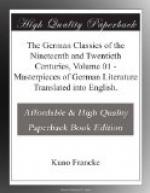Like all “natural geniuses” Goethe begins as an imitator, dependent upon others; for the poet also must first learn to speak and to walk. The earliest literary effort of his which we possess is the poem On Christ’s Descent into Hell, which naturally seemed strange enough to Goethe when this long forgotten first printed specimen of his literary productiveness was laid before him again after he had grown old. In this poem traditional phrases are repeated without the addition of anything new and original; conventional feelings are expressed, usual methods are employed; all this, however, not without a certain moderation of expression constituting a first sign of the otherwise still completely concealed poetic individuality.
Such is the character that the world of virtuosos also bears about the year 1700. The poems of Rudolf von Canitz and Johann von Besser are, though in entirely different spheres, just the same kind of first attempts of an imperfect art anxiously following foreign models as Goethe’s first Christian poem—though truly with the tremendous difference that they represented the utmost that Frenchified courtly art could ever attain to; while Goethe’s poem, on the contrary, was the immature sprig cut away before its time from the stem of a tree soon to stand in the full glory of its bloom.
When now in the Leipzig period the young student discovers the poet within him, he first does so in the customary way: he recognizes the ability on his part to handle the language of the contemporary poets, and also perhaps to imbue it with his own personal feelings. His poems inserted in letters, which make a show of the elegant pretence of improvisation, but in reality already display a great dexterity in rhyming and in the use of imagery, may be compared to Hagedorn’s poetry; but at the same time Goethe is trying to attain the serious tone of the “Pindarian” odes, just as Haller’s stilted scholarly poetry conquered a place beside Hagedorn’s Epicurean philosophy of life. The Book of Annette (1767) as a whole, however, presents the first attempt on the part of Goethe to reach a certain completeness in his treatment of the poetic theme. In all his subsequent collections of poems the same attempt is made, it is true with increasingly rigid interpretation of the idea of “completeness,” and in so far one is reminded in this connection of the theoretic intentions and performances of Gottsched.
The “New Songs” (Neue Lieder) of 1770 give a lop-sided exhibition of the style which Leipzig and the times acts. Two great acts follow: in 1773 comes Goetz; in 1774, Werther. And with Goetz the great “subjects of humanity” seize possession of Goethe’s poetry, as they had taken possession of the poetry of Germany with Lessing—as shown by his whole work up to Nathan: for Lessing, the strongest adversary of mere “estheticism,” really accomplished what those Anacreontic poets had




